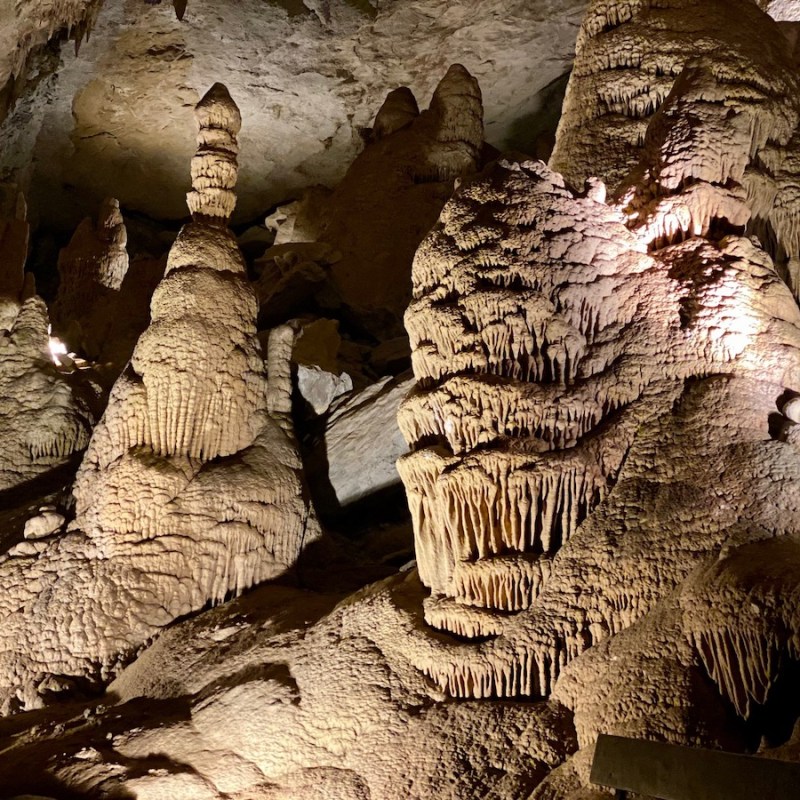
“You gotta be kidding me!” I hissed under my breath as I looked up the more-than-30-foot ladder leading up to a dark ledge above me. I was miles under the earth, deep in the belly of Cumberland Caverns near Sparta, Tennessee, and the ladder was just another challenge I had to face while exploring the underworld.
Videos by TravelAwaits
I’m a huge fan of wild caving. Sure, I love the cave tours that are well lit with smooth paths that showcase the stalagmites and stalactites for tourists. For many people, these show caves are an easy and safe way to see the wonders beneath our feet.
But the still-wild, still-young part of me loves crawling and scrambling in the darkness, getting that edgy feel of danger when exploring wild caves with only a guide or my own gumption. At Cumberland Caverns, my friend Emily (who had never been caving) and I opted for the Legacy Tour Adventure.
This tour was rated “extreme and strenuous,” and boy, did it live up to its rating. With local caving expert Chuck Sutherland and our 19-year-old cave guide Collin, we spent 4 hours deep in the more than 30 miles of mapped passages in Cumberland Caverns, scrambling over ancient rock falls; squeezing like worms through twisting, tight rock passageways; using guide ropes to navigate sketchy landings; and marveling at awe-inspiring cave sculptures that few people ever see.
North America has a wealth of cave systems. They range from massive ones like Mammoth Cave in Kentucky, the world’s largest cave system and a UNESCO biosphere reserve and heritage site, to lava tubes like Ape Cave, a 2.5-mile cave created by an eruption on Mount Saint Helens almost 2,000 years ago. There are even caves you can rappel in, like the Rat’s Nest Cave in Alberta.
I bought land in Arkansas with a small, mile-long cave because I love caving so much. That said, caving isn’t for the faint of heart and requires some safety precautions and planning. Having the right gear is essential, as is knowing what your limitations are.
However, if you have that mole-rat spirit and want to see parts of the Earth that few people have the opportunity or the courage to explore, you’ll find magical landscapes that never see the light of day and a rich biosphere of experiences as well.
Chuck is an experienced caver and cave guide who is active in his local caving club and takes part in the cave surveys in Tennessee.
Before heading out to do some wild caving, read Chuck’s five tips for experiencing wild caving in North America.
Note: I was hosted in part by Tennessee Tourism and by Visit British Columbia on a couple of these caving tours. All opinions are my own.

1. Do Your Research
For the safety and conservation of America’s caves, experts discourage cavers from visiting most places until they are experienced. Chuck said that most state park systems offer cave tours, and many have wild caves that are open to the public.
“We don’t share cave locations. And we typically try to discourage people from visiting wild caves, because most people don’t have the experience or ability to navigate through complex, three-dimensional subterranean terrains. We want them to be safe,” he said. “Some of these caves have really precious resources that, once destroyed, never exist again. And so for the safety and conservation of the cave, we like to discourage visitation for most places until you’re an experienced caver.”
Chuck suggested contacting the National Speleological Society to get connected with local grottos (caving clubs) or contacting the state parks or National Park Service for information about cave tours and wild caving within state and national parks.
Pro Tip: Decide which experience is right for you by asking about the difficulty or strenuousness of the cave tours you find. Some are geared toward beginners, while others can be pretty extreme, even for experienced cavers. Don’t be afraid to admit that you are a beginner. The park personnel are there to help you have the best possible trip.
2. Be Honest About Your Ability
Caving can be dangerous and challenging, so take an honest look at your physical and mental ability to engage in long-distance hiking over uneven ground and lots of climbing. You’ll also need to consider your fears and your stamina.
“You should have some idea of your own personal limitations, and you need to be in reasonably good shape. The last thing that you want to have happen is getting underground and losing energy or losing your cool,” Chuck said.
“It’s easier to hurt yourself physically in a cave. Getting out of the cave when you’re injured is very complicated. Some people are afraid of darkness. Some people are afraid of heights. Some people have other notions about things going on in caves, like monsters, which sounds ridiculous, but you’d be surprised how frequently I hear that. Know yourself and your fears.”
Even a beginner wild caving experience requires physical strength and stamina, as well as good mobility.

3. Wear The Right Gear
When I was caving at Cumberland Caverns, I wore sturdy hiking boots, layers, and hiking pants. While my hiking boots and quick-drying T-shirt and light jacket worked great, my poor light cotton hiking pants didn’t survive the hours of butt-scooting and scrambling. I ended up ripping my pants completely down the seat, and I spent the rest of the cave tour with my underwear and buttcheeks on display.
“You definitely need sturdy clothes. I stay away from cotton, because it can also get pretty cold and wet inside a cave. It’s easy to get hypothermia if you are wet inside a cold cave,” Chuck said. “Wear synthetic, quick-drying clothes. I also say, if you can’t bend your shoes easily lengthwise, they are good shoes for caving.”
While many wild caving tours will provide you with gear, consider also wearing knee pads and sports gloves to protect your knees and palms. A good caving helmet is an absolute must, as is a quality headlamp. You’ll want to bring extra headlamps or extra batteries, too.
“I also tell people they should have a good snack and at least 1 liter of water for every 3 hours underground,” Chuck said. “The way that we move our bodies through caves is a full-body experience, with climbing or crawling or walking or stooping. As you get warm, you start losing water through your skin and through your breath, which is your body’s way of trying to keep you cool. So it’s pretty easy to get dehydrated in that situation just because you’re being active.”
Pro Tip: Chuck wears heavy-duty cargo shorts when he goes caving because his knee pads fit better over his knees without pulling at his clothing. Good hiking boots or sturdy sports shoes with good treads are great for caving.
4. Leave No Trace
Responsible cavers follow the Leave-No-Trace philosophy. When caving, try to limit how much your body comes in contact with cave formations, stick to the established paths, don’t remove anything, don’t mess with any wildlife that may be living in the cave, and take out all your trash.
But what about going to the bathroom? Folks, that’s what an empty sports bottle is for!
“Recognizing that you’re not part of that ecosystem and that no matter what you do, you’re going to have an impact is important. We just try to minimize that impact as much as possible,” Chuck said.

5. Start Out With A Guided Caving Experience
Not only is it safer to do a caving excursion with a legitimate guide, but it’s more rewarding as well, especially for newcomers to the sport. A guide can help you navigate difficult terrain safely, can point out amazing features of the cave you might otherwise miss, and can provide assistance if you find yourself in a bind.
Guided cave tours usually also have equipment available for use or rent, and overall, you’ll be in better hands than you would trying to navigate a dark, deep cave on your own.
Nearly every U.S. state and Canadian province has wild caving experiences that you can sign up for, but here are a few outstanding ones:
- Cumberland Caverns, McMinnville, Tennessee
- Mammoth Cave National Park, Kentucky (Many of the wild caving tours are currently unavailable but may reopen later this year.)
- Caverns of Sonora, Sonora, Texas
- Horne Lake Caves, Vancouver Island, British Columbia
- Oregon Caves National Monument & Preserve, Oregon
- Marengo Cave, Indiana
- Carlsbad Caverns National Park, New Mexico
